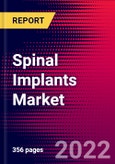Throughout this medical market research, the publisher analyzed 28 spinal implant companies bone graft substitute companies across Taiwan and utilized their comprehensive methodology to understand the Market Sizes, Unit Sales, ASPs, Company Market Shares, and to create accurate forecasts.
One market limiter of the Taiwan market in 2021 was the increase of minimally invasive spinal (MIS) implants within the market. High growth within MIS devices will limit growth in many large segments, including the thoracolumbar, interbody device and dynamic stabilization markets. The cannibalization of these procedures is due to the perceived patient benefits of MIS procedures, including lower blood loss, quicker recovery time and shorter surgery times.
One major driver of the Taiwanese market in 2021 is favorable reimbursement. Instrumented spinal fusions have long been considered the standard of care for spinal implant surgery. Insurance providers recognize the long-term history of spinal fusions as well as their medical necessity. Interbody fusion procedures are generally fully reimbursed, thereby creating a favorable reimbursement landscape that drives the market.
An ongoing trend in the Taiwan market is the increase in favorable demographics. Both fusion and non-fusion procedures are typically performed in order to treat spinal complications that are much more common in elderly patients.
In Taiwan, approximately 16% of the population was over 65 years of age in 2021, and this is expected to grow to 23% by 2030. Growth of this population is expected to stimulate growth in both the fusion and non-fusion spinal implant markets.
Overall, the Taiwanese spinal implant and VCF market was valued at approximately $232 million in 2021. This is expected to increase over the forecast period at a CAGR of 3.6% to reach nearly $296 million.
One market limiter of the Taiwan market in 2021 was the increase of minimally invasive spinal (MIS) implants within the market. High growth within MIS devices will limit growth in many large segments, including the thoracolumbar, interbody device and dynamic stabilization markets. The cannibalization of these procedures is due to the perceived patient benefits of MIS procedures, including lower blood loss, quicker recovery time and shorter surgery times.
One major driver of the Taiwanese market in 2021 is favorable reimbursement. Instrumented spinal fusions have long been considered the standard of care for spinal implant surgery. Insurance providers recognize the long-term history of spinal fusions as well as their medical necessity. Interbody fusion procedures are generally fully reimbursed, thereby creating a favorable reimbursement landscape that drives the market.
An ongoing trend in the Taiwan market is the increase in favorable demographics. Both fusion and non-fusion procedures are typically performed in order to treat spinal complications that are much more common in elderly patients.
In Taiwan, approximately 16% of the population was over 65 years of age in 2021, and this is expected to grow to 23% by 2030. Growth of this population is expected to stimulate growth in both the fusion and non-fusion spinal implant markets.
Overall, the Taiwanese spinal implant and VCF market was valued at approximately $232 million in 2021. This is expected to increase over the forecast period at a CAGR of 3.6% to reach nearly $296 million.
Table of Contents
EXECUTIVE SUMMARY
RESEARCH METHODOLOGY
IMPACT OF COVID-19 ON THE TAIWAN SPINAL IMPLANT AND VCF MARKET
DISEASE OVERVIEW
PRODUCT ASSESSMENT
TAIWAN SPINAL IMPLANT AND VCF MARKET OVERVIEW
PROCEDURE NUMBERS
CERVICAL FIXATION MARKET
THORACOLUMBAR FIXATION MARKET
INTERBODY DEVICE MARKET
MOTION PRESERVATION DEVICE MARKET
VERTEBRAL COMPRESSION FRACTURE MARKET
SPINAL SURGERY INSTRUMENTATION MARKET
APPENDIX: ELECTRICAL STIMULATION MARKET
Companies Mentioned (Partial List)
A selection of companies mentioned in this report includes, but is not limited to:
- AAXTER
- Apex Spine
- A-Spine
- B. Braun
- BAUI Biotech
- BioMech Poanan Biotech
- BLESS ALL
- BMI
- Centinel Spine
- Cousin Biotech
- CTL Amedica Corporation
- DePuy Synthes
- Dragon Crown Medical
- INTAI
- Kailitai Medical
- Medtronic
- MegaSpine
- Scient x
- SIGNUS Medical
- Spineart
- SpineVision
- Spirit Spine
- Stryker
- Suzhou Aide
- Syntec Scientific Corp
- Ulrich Medical
- Wiltrom
- Zimmer Biomet








